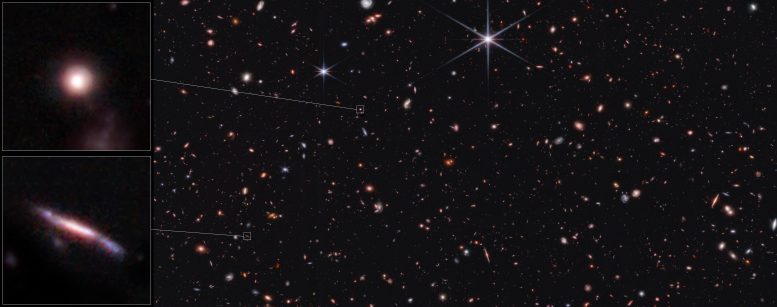
Advancements in telescopic technology, particularly with the James Webb Space Telescope, have enhanced the classification of galaxy shapes. A recent study analyzed distant galaxies, revealing a prevalence of unusual flat and elongated shapes in the early universe, contrasting with nearer galaxies. This challenges previous assumptions about galaxy formation and evolution. Credit: NASA, ESA, CSA, STScI, Steve Finkelstein (UT Austin), Micaela Bagley (UT Austin), Rebecca Larson (UT Austin)
Recent observations by the James Webb Space Telescope have revealed that many distant galaxies in the early universe possess unique flat and elongated shapes, differing significantly from closer galaxies. This finding, confirming and expanding upon Hubble’s earlier observations, offers new insights into galaxy evolution and challenges existing theories.
For more than a century, astronomers have categorized galaxies near and far, both by comparing their shapes by eye and precisely measuring their properties with data known as spectra. For example, Edwin Hubble created the Hubble Tuning Fork (see image below) in 1926 to begin to sort the shapes and sizes of nearby galaxies, showing that many are spirals and ellipticals.
As telescopes’ instruments have become increasingly more sensitive, it is easier to more accurately classify their shapes. New data from the James Webb Space Telescope have added nuances to astronomers’ classifications. Since Webb observes in infrared light, many more extremely distant galaxies appear in its images. Plus, the images are finely detailed, allowing researchers to identify if there are additional areas of star formation – or confirm they aren’t present.
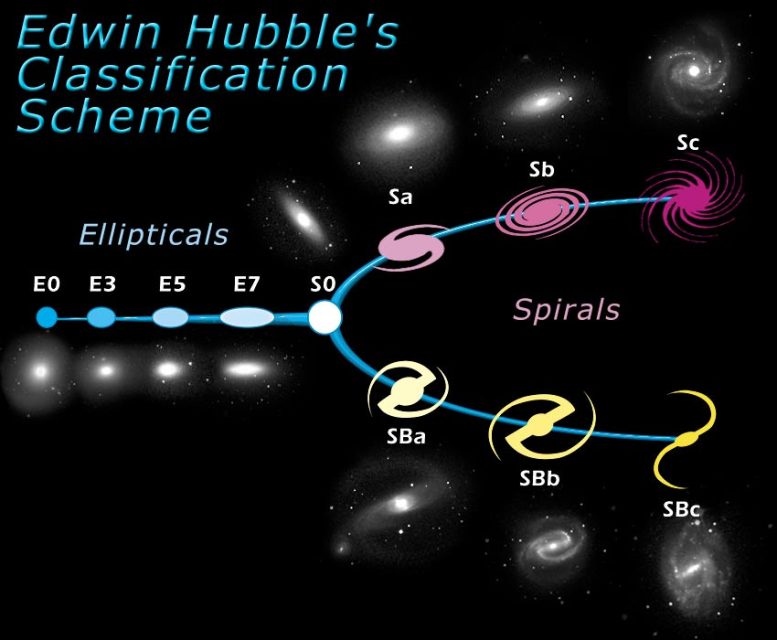
Galaxies are very important fundamental building blocks of the Universe. Some are simple, while others are very complex in structure. As one of the first steps towards a coherent theory of galaxy evolution, the American astronomer Edwin Hubble, developed a classification scheme of galaxies in 1926. Although this scheme, also known as the Hubble tuning fork diagram, is now considered somewhat too simple, the basic ideas still hold. Credit: NASA
A team led by Viraj Pandya, a NASA Hubble Fellow at Columbia University in New York, recently analyzed hundreds of distant galaxies in Webb’s Cosmic Evolution Early Release Science (CEERS) Survey (see image below). CEERS intentionally covers much of the same area as the Hubble Space Telescope’s Extended Groth Strip (see image below), which was one of the five fields used to create the Cosmic Assembly Near-infrared Deep Extragalactic Legacy Survey (CANDELS). This allowed them to double-check Webb’s results where the telescopes’ observations overlap.
“Our analysis of Webb’s galaxies was very consistent with galaxies in the Hubble Space Telescope catalog,” Pandya confirmed. “Two sets of data allowed us to fully vet our models as we ran our analysis, and better understand and categorize galaxies that only Webb detected.” The team began their analysis by sorting the galaxies into broad classes based on similar characteristics. (They did not classify each galaxy’s individual appearance since that would require detailed information from data known as spectra.)
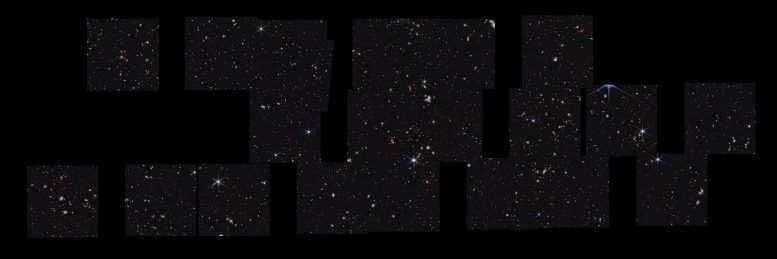
Stare deeply at this vast landscape. It was stitched together from multiple images captured by the James Webb Space Telescope in near-infrared light – and it is practically pulsing with activity. Credit: NASA, ESA, CSA, Steve Finkelstein (UT Austin), Micaela Bagley (UT Austin), Rebecca Larson (UT Austin), Alyssa Pagan (STScI)
They found an array of odd shapes when the universe was 600 million to 6 billion years old. The galaxy shapes that dominate look flat and elongated, like pool noodles or surfboards. These two galaxy types make up approximately 50 to 80% of all the distant galaxies they studied – a surprise, since these shapes are rare closer to home.
Other galaxies Webb detected appear round but also flattened, like frisbees. The least populated category is made up of galaxies that are shaped like spheres or volleyballs.

This image from the Hubble Space Telescope shows a part of the sky known as the Extended Groth Strip (EGS). The CEERS Survey researchers used the James Webb Space Telescope to observe the Extended Groth Strip in infrared light. Credit: NASA, ESA, M. Davis
Webb’s data also resolved a riddle that was introduced by the Hubble Space Telescope’s observations decades ago. Why do so many distant galaxies appear like long lines? Was there more to the galaxies that didn’t appear in its images? Webb answered this in short order: Hubble hasn’t missed anything.
“Webb confirmed what Hubble has long shown us, but in greater detail in infrared light,” Pandya said. “Their combined observations show that in the early universe, many more galaxies appear flat and elongated. This has profound implications, since we usually assume that galaxies like our own Milky Way started out as disks, but that may not be the case.”
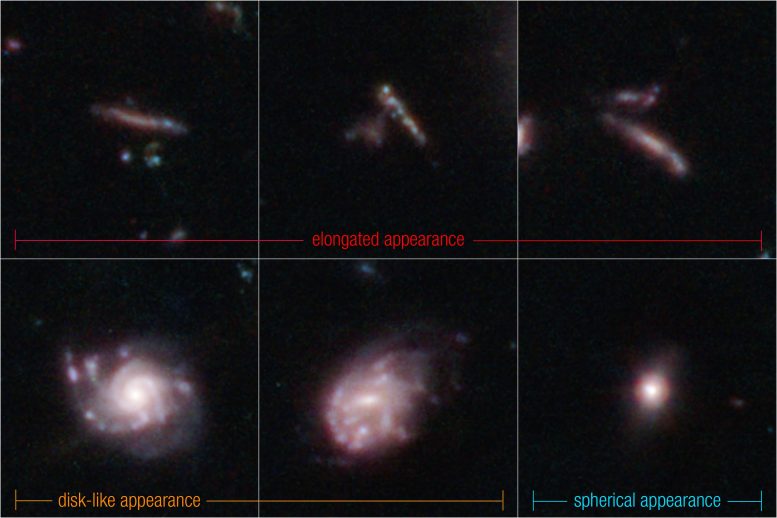
These are examples of distant galaxies captured by NASA’s James Webb Space Telescope in its Cosmic Evolution Early Release Science (CEERS) Survey. Credit: NASA, ESA, CSA, STScI, Steve Finkelstein (UT Austin), Micaela Bagley (UT Austin), Rebecca Larson (UT Austin)
Why do galaxies have such different shapes early in the history of the universe? This question remains unanswered for now, but research is underway to better understand how galaxies evolved over all of cosmic time.
See more galaxy samples (see image above from Webb’s CEERS Survey and more concretely compare their 3D shapes (see image below).
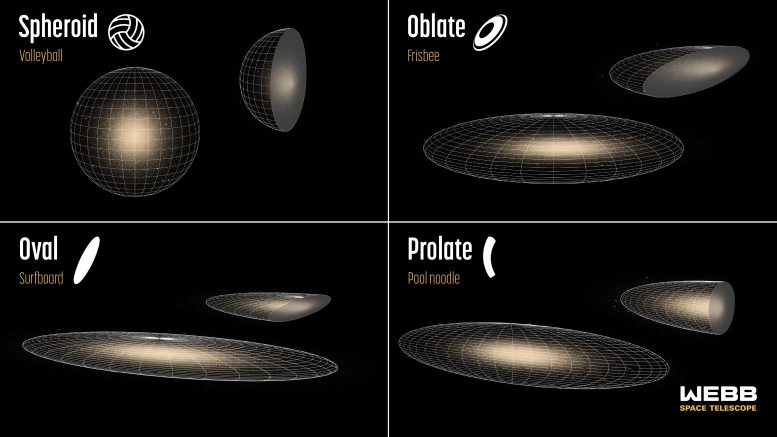
The James Webb Space Telescope is already helping researchers fine-tune their classifications of distant galaxies – adding significant speed and detail to analysis that has been underway for decades.
At top left, Webb’s survey shows a classification that’s rare in the early universe, but common today: Galaxies that are shaped like spheres or volleyballs.
At top right are flattened circular disks or frisbees, which are only slightly more common.
The galaxy shapes that dominate during this early period look flat and elongated, like surfboards, shown at bottom left, or pool noodles, bottom right. This pair of classifications make up approximately 50 to 80% of all distant galaxies they’ve studied so far – a surprise, since these shapes are uncommon nearby.
The advances in astronomers’ classifications are owed to Webb’s sensitivity, high-resolution images, and specialization in infrared light. The astronomical community will also need to fully classify more distant galaxies with much larger sample sizes from Webb and other telescopes before settling on any firm groupings.
Credit: NASA, ESA, CSA, Joseph Olmsted (STScI), Viraj Pandya (Columbia), Haowen Zhang (University of Arizona), Lucy Reading-Ikkanda (Simons Foundation)
“By continuing this research, we and other teams will be able to improve our understanding of the intrinsic structure of galaxies at this point in the history of the universe,” explained co-author Elizabeth McGrath, an associate professor at Colby College in Waterville, Maine. “By eventually combining information from multiple datasets, we will better understand galaxy shapes over all of cosmic time.”
For more on this study:
- Webb Telescope Reveals Many Early Galaxies Looked Like Pool Noodles and Surfboards
- “Galaxies Going Bananas” – New Surprises From NASA’s Webb Space Telescope
Reference: “Galaxies Going Bananas: Inferring the 3D Geometry of High-Redshift Galaxies with JWST-CEERS” by Viraj Pandya, Haowen Zhang, Marc Huertas-Company, Kartheik G. Iyer, Elizabeth McGrath, Guillermo Barro, Steven L. Finkelstein, Martin Kuemmel, William G. Hartley, Henry C. Ferguson, Jeyhan S. Kartaltepe, Joel Primack, Avishai Dekel, Sandra M. Faber, David C. Koo, Greg L. Bryan, Rachel S. Somerville, Ricardo O. Amorin, Pablo Arrabal Haro, Micaela B. Bagley, Eric F. Bell, Emmanuel Bertin, Luca Costantin, Romeel Dave, Mark Dickinson, Robert Feldmann, Adriano Fontana, Raphael Gavazzi, Mauro Giavalisco, Andrea Grazian, Norman A. Grogin, Yuchen Guo, ChangHoon Hahn, Benne W. Holwerda, Lisa J. Kewley, Allison Kirkpatrick, Anton M. Koekemoer, Jennifer M. Lotz, Ray A. Lucas, Laura Pentericci, Pablo G. Perez-Gonzalez, Nor Pirzkal, Dale D. Kocevski, Casey Papovich, Swara Ravindranath, Caitlin Rose, Marc Schefer, Raymond C. Simons, Amber N. Straughn, Sandro Tacchella, Jonathan R. Trump, Alexander de la Vega, Stephen M. Wilkins, Stijn Wuyts, Guang Yang and L. Y. Aaron Yung, Accepted, The Astrophysical Journal.
arXiv:2310.15232

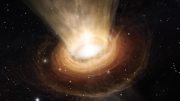


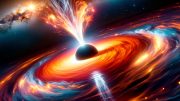
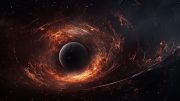
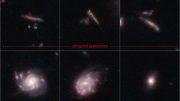


Be the first to comment on "Cosmic Oddities: Webb Telescope’s Glimpse Into the Universe’s Eccentric Infancy"